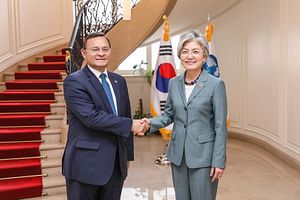Peru may not be South Korea’s most obvious partner in global affairs, but last week’s meeting between their two foreign affairs ministers emphasized the significance of the relationship.
On the sidelines of the two-day OECD Ministerial Council Meeting, South Korea’s Minister of Foreign Affairs Kang Kyung-wha met with her counterpart from Peru, Nestor Popolizio. Meetings like these are a carefully calculated diplomatic tool. The meeting with the delegation from Peru was one of only three Kang took separate from the OECD conference. The others were with France and Japan.
Of the three meetings, Peru is seemingly the odd one out. France is a natural fit as it hosts the OECD and South Korea is again in a high-profile disagreement with Japan over historical issues. South Korea’s trade volume with both countries, especially when France is considered in the context of the European Union, is much higher than with Peru. Both are also OECD members, while Peru is trying to meet the requirements of joining the institution. However, Lima’s leadership in other multilateral institutions this year likely played an outsized role in Seoul’s calculus to pursue the Kang-Popolizio meeting. Peru’s nonpermanent membership on the UN Security Council (UNSC) and chairmanship of the Pacific Alliance can help to advance two key South Korean strategic goals.
South Korean President Moon Jae-in’s most important foreign policy priority is undoubtedly finding a peaceful solution to the North Korean security challenge. Given the sprawling UN sanctions regime on North Korea, UNSC member cooperation to lift sanctions when the timing is right is crucial for Moon’s ambitious diplomatic plans to succeed. It is thus not surprising that the press release from the meeting states that Kang specifically asked for Peru’s support in achieving peace and denuclearization on the Korean Peninsula, which Popolizio reaffirmed. Peru notably expelled the North Korean ambassador posted in Lima in September 2017 after Pyongyang’s sixth nuclear test, but this aligned with the mounting international disapproval of North Korea’s provocations at the time.
Peru’s current position in the Pacific Alliance can also facilitate the Moon government’s efforts to diversify international economic ties. A regional initiative comprised of Chile, Colombia, Mexico, and Peru, the Pacific Alliance was created to deepen economic integration among its members and is oriented toward the Asia-Pacific. South Korea is currently one of 54 observer states but is seeking to upgrade to associate member status to increase trade with the bloc. Moon asked Chilean president Sebastian Pinera, whose country will assume the rotating chair later this year, for his support for the bid at a summit in April. Furthering an apparent strategy of high-level diplomatic engagement, Kang asked for Peru’s support in its Pacific Alliance bid last week.
Although Lima’s term on the UNSC and as head of the Pacific Alliance will end this year, there should be enough at the bilateral level to maintain the importance of the relationship moving forward.
The two countries signed a free trade agreement (FTA) in 2011 and upgraded ties to a strategic partnership in 2012. While South Korea’s exports to Peru have dipped since the FTA came into force, Seoul has been actively looking to enhance economic cooperation with Peru. In an interview last year, South Korean Ambassador to Peru Cho June-hyuck emphasized how South Korean investment could prove mutually beneficial, stating, “At the moment, Peru exports a lot of minerals and agricultural products; that is, raw materials. But if we work together, you [Peru] can add value to them, thus industrializing your exports not only to South Korea but all over Asia.” In her meeting with Popolizio, Kang further brought up involving South Korean companies in major Peruvian infrastructure projects, mentioning construction of the Chinchero international airport. Her reference to working more closely on smart cities and e-governance – two areas of South Korean competitive advantage – additionally signal that South Korea is looking to get more involved in the Peruvian economy.
Outside of official relations, there is also great interest in the Korean culture in Peru, particularly K-pop. South Korean artists received over 100 million streams from Peruvian listeners last year. Even though it is only ranked 43rd in the world by population, Peru was 10th last year in YouTube views of the worldwide sensation BTS.
While South Korea can often get swept away in narratives on North Korea, meetings like last week’s with Peru should serve as a reminder of its broader engagement in international affairs.
Kyle Ferrier is the Director of Academic Affairs and Research at the Korea Economic Institute of America (KEI) and a contributor to The Diplomat’s Koreas blog.

































